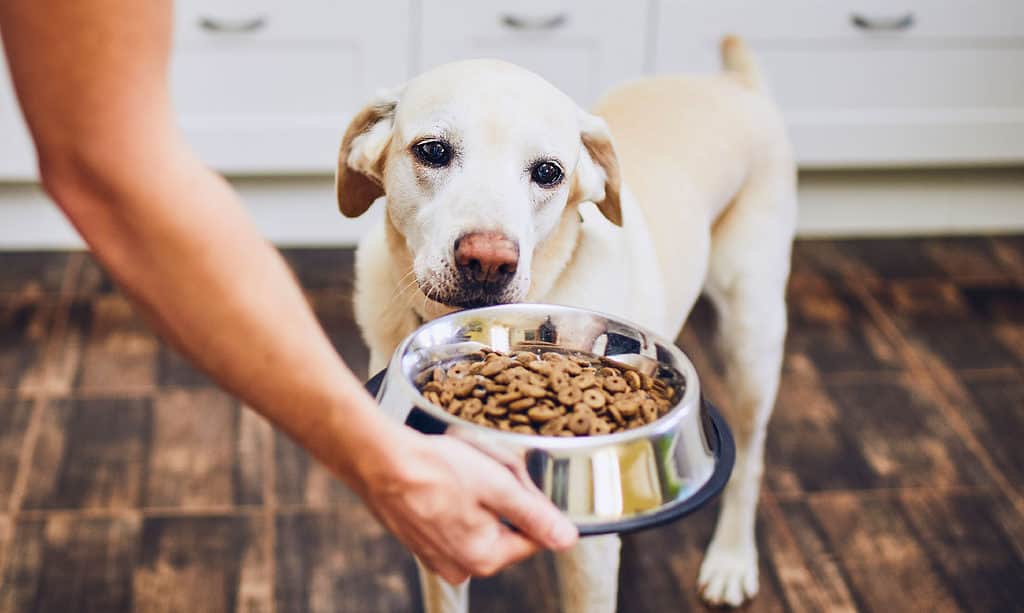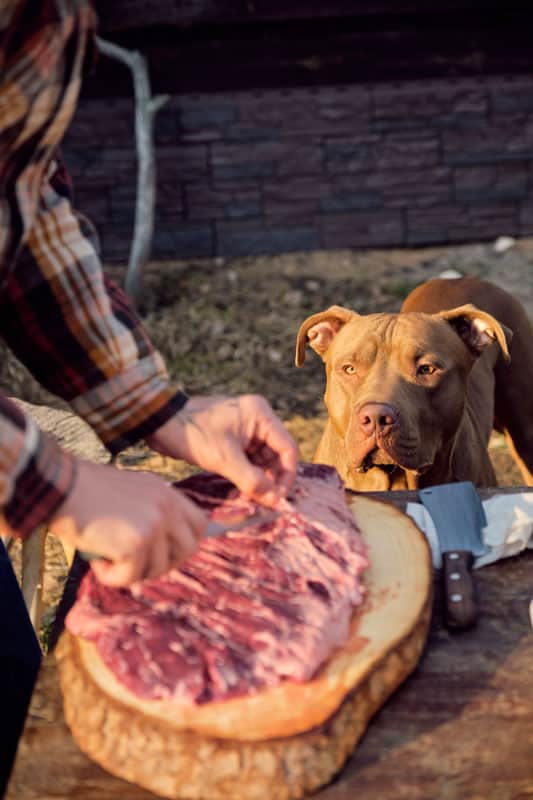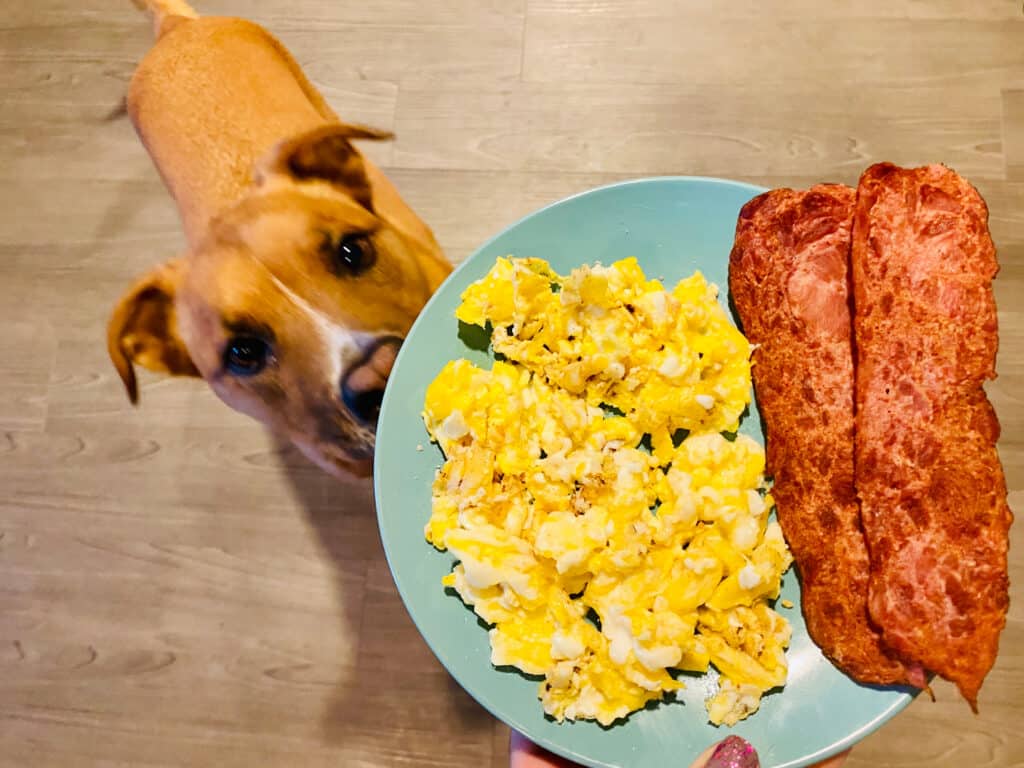When your dog sits at the foot of your dinner table begging for food with big, loving eyes, it is hard to resist giving them a little something off your plate. Some people like cooking their dogs’ fresh meals on special occasions or regularly. So, what foods must we avoid? Can our pets eat meat like their wild canine ancestors? This article will find out if dogs can safely eat steak, then it will discuss how much they can eat, and what happens if they eat too much.
What Is a Domestic Dog’s Typical Diet?

©iStock.com/Chalabala
Most domestic dogs eat human-manufactured kibble. Typical dog foods are either dry pellets or canned wet food. In the United States, more than 90% of dog owners feed their furry friends kibble. Although kibble has been linked to many chronic diseases in dogs, it has been the staple dog food since the industrial revolution.
Different dog food brands have different ingredients of varying quality. Most dry kibble includes chicken or beef and grains. Lamb and grain food is also common, as well as salmon, or sweet potato kibble. Dog food also often has corn that is hard to digest. Corn is frequently used as “filler” in cheaper dog foods because it is relatively inexpensive. Some foods may also contain preservatives, MSG, and nitrates.
How Do Dogs Compare to Wolves?

©iStock.com/Dmytro Lastovych
The domestic dog is a direct descendant of wolves. They descended from gray wolves approximately 130,000 years ago! Wolves are carnivorous pack animals that hunt cooperatively. They most commonly feed on herbivorous hoofed mammals, including animals much larger than them. There are frequent human-wildlife conflicts involving wolves and livestock. Sheep, goats, and calves are the livestock most commonly attacked by wolves.
One might expect that wolves and domestic dogs share similar features because of their close evolutionary relationship, including adaptations related to their diet. Wolves have four large canine teeth that evolved to efficiently penetrate and rip animal flesh. They also have incredible bite force that allow them to clamp on to their prey. Domestic dogs have retained these traits to some extent. They have prominent canines capable of processing meat and some breeds have impressive bite forces.
Can Dogs Eat Steak?

©iStock.com/DeRepente
So, can dogs eat steak? As a matter of fact, dogs can eat steak but there are three main rules. First of all, although dogs can easily digest raw meat, cooked meat is preferred. Raw beef can carry food-born illnesses or have bacteria that can negatively affect a dog’s health. Raw beef can expose dogs to salmonella, E. coli, Yersinia, and other bacteria. Cooking meat before a dog eats it kills the bacteria and still provides a healthy, protein-packed, lean snack.
A second important rule is that steak fed to a dog must not have seasoning or sauce on it. Many steak rubs and marinades have salt, garlic, and other ingredients that can be harmful to dogs. Too much salt can cause a dog to have excessive thirst and excessive urination. In severe cases, dogs can experience, ataxia, weakness, diarrhea, vomiting, tremors, and seizures from ingesting too much salt. Garlic and some other common ingredients also can cause pancreatitis. Smaller dogs, like chihuahuas and small terriers are especially susceptible to pancreatitis and can fall ill from even small amounts of garlic.
A third rule to feeding your dog steak is that some cuts of meat are healthier than others. Low-fat meat cuts are the healthiest option for your dog, such as a top round or bottom round. Ideally, meat for a pet dog should have less than 10% fat content.
How Much Steak Can a Dog Eat?
If dogs eat too much steak, they may become obese. Also, if a dog frequently eats steak with high fat content, they can gain weight more quickly and potentially develop heart issues. When steak is fed to a dog regularly, the most important factor to consider is portion control. If you feed your dog a substantial amount of steak on a regular basis, talk to your vet about how much kibble is appropriate to feed them as well. Often, pet owners give their animals significant amounts of meat scraps and do not reduce that amount of kibble their dog gets regularly. Steak in small amounts can be a good treat in addition to a dog’s existing food, but if they eat large amounts of meat regularly, the amount of kibble they get may need to be adjusted.
An all-meat diet is not recommended for domestic dogs. Meat alone does not contain all of the nutrients and vitamins your dog needs and can be damaging to their health if they don’t take supplements. Meat-based diets can be healthy when supplemented by other fresh foods or kibble, but proper nutritional needs must be taken into account and discussed with a veterinarian.
How Should You Prepare a Steak for Your Dog?

©iStock.com/AnnaStills
Preparing a fabulous steak dinner for your spoiled pooch is quite simple. First select a cut of meat with low fat content. If there is excess fat, cut it off if you can. Then, remove any bones or bone shards that are small and could be a choking hazard. Larger bones may be a safe and enjoyable treat, but small bones or bone fragments can be painful to chew and swallow or could be a choking hazard.
When cooking the steak, be sure not to cook it in a large amount of butter and not to use any seasonings. The steak might be bland to a human, but your pup will still love it plain! Cook the steak until it reaches a “medium” doneness level so no pink is left in the center. You can check the internal temperature with a food thermometer. The internal temperature of the meat should be between 140-145 degrees Fahrenheit when it’s finished. Let it cool before serving. Then, serve it to your pup and watch them go crazy for the delicious treat!
Bonus: Can My Dog Eat Bacon?

A dog would give anything for a slice of bacon.
©N K/Shutterstock.com
If you have a dog and eat bacon – you’ve no doubt been subjected to the most dramatic begging displays in your pup’s repertoire after they get a whiff of it frying in the pan. Maybe you couldn’t resist and offered one tiny bite – perhaps you tend to spoil your dog baby with a whole piece! You may think that bacon is just meat and your little wolf will be just fine. Unfortunately, that is not the case.
Opting for the small bite won’t hurt your pet – but giving them the whole piece or any amount of bacon on a regular bases is not recommended by vets. It could result in pancreatitis and gastrointestinal issues such as constipation, diarrhea, gas, and abdominal pain. Bacon has a lot of fat and salt that isn’t good for your dog. It isn’t toxic like chocolate, onions, or garlic – so your occasional small bacon treats aren’t going to send you to the emergency vet – but it is definitely not healthy. Reward your pet’s efforts to secure the bacon with one of its regular dog treats instead. She may be disappointed but any treat is better than nothing!
The photo featured at the top of this post is © iStock.com/vasiliybudarin
Ready to discover the top 10 cutest dog breeds in the entire world?
How about the fastest dogs, the largest dogs and those that are -- quite frankly -- just the kindest dogs on the planet? Each day, AZ Animals sends out lists just like this to our thousands of email subscribers. And the best part? It's FREE. Join today by entering your email below.
Thank you for reading! Have some feedback for us? Contact the AZ Animals editorial team.






